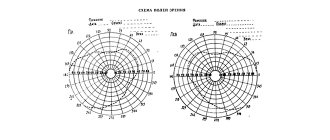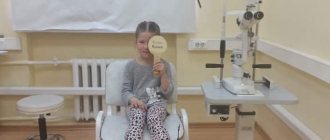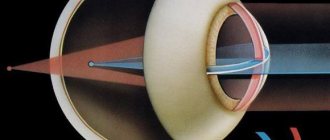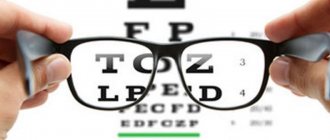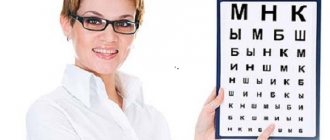|
Visual acuity
|
Refraction
|
Eye test
| |
We are faced with the need for a vision test every time we go to school or get a new job, undergo a medical examination at the military registration and enlistment office or to obtain a driver's license. But are we always aware of what exactly is determined in the ophthalmologist’s office and what is meant by a “vision test”? In many cases, an eye test simply involves checking visual acuity, although this is not the only important characteristic of our eyes.
Currently, a large number of sites offer online vision testing. The process looks simple - you need to select a vision test table that matches the diagonal of your monitor and move away 1-2 meters. However, vision testing in such conditions gives an extremely approximate result and there are several reasons for this: the size of optotypes (letters, geometric figures), the required image contrast, as well as the distance to the table, which must be at least 4 meters (standard in Russia - 5 meters, in foreign countries - 6 meters) to avoid the influence of accommodation on the result obtained.
Another drawback of such tests is that they omit checking such a rather important vision parameter as refraction. Then how can you use this indicator to determine whether you have nearsightedness, farsightedness and/or astigmatism?
We offer you the option of checking basic vision parameters at home, which gives the closest approximation to vision testing in medical institutions. You may find it a little more complicated than on other sites, and it will take a little more time, but the result will be much more accurate.
Before proceeding directly to the vision test, it is necessary to make some clarifications regarding visual acuity (VA) and refraction. Most people confuse these concepts. We will try to explain their meaning as clearly as possible, resorting to a certain simplification and deviating from the formulations accepted in ophthalmology.
Visual acuity
In accordance with professional terminology, visual acuity is the ability of the eye to distinguish between two points with a minimum distance between them. According to the conventionally accepted norm, an eye with 100% vision (V=1.0) is able to distinguish between two distant points with an angular resolution of 1 minute (or 1/60 of a degree).
In a strong simplification, this means that visual acuity is a qualitative indicator of eye vigilance, making it possible to measure how well (clearly) a person sees. Visual acuity of 1.0 (100%) is accepted as the norm - the so-called unit. It is determined using special tables with optotypes. In our country, the most common is the Golovin-Sivtsev table (or simply the Sivtsev table).
A person may have visual acuity greater than normal, for example - 1.2 or 1.5, or even 3.0 or more. In the case of problems such as refractive errors (myopia, farsightedness), astigmatism, cataracts, glaucoma, etc., visual acuity drops below normal, for example - 0.8 or 0.4, or 0.05, etc.
There are often attempts to express visual acuity as a percentage. However, it should be borne in mind that simply converting this indicator into a percentage is incorrect. In such a recalculation, everything is much more complicated, since it is necessary to take into account other parameters that determine the quality of vision. Therefore, although 1.0 is 100% vision, but, for example, 0.2 is not 20, but 49% of the norm. Similarly, any indicators of visual acuity that differ from one cannot be converted into percentages by ordinary arithmetic.
What is the difference in visual acuity? The main difference is the distance from which people see the same object equally clearly. For example, a person with visual acuity of 1.0 can read a license plate from approximately 40 meters, provided there is sufficient lighting. The lower the HP, the shorter the distance from which the number will be read. With a visual acuity of 0.4, this distance will be approximately 16 meters. At a greater distance, numbers and letters will already merge or become simply indistinguishable.
Another example is that a person with visual acuity of 1.0 reads the top line of the test table from a distance of 50 meters, and with a visual acuity of 0.1 - from no further than 5 meters.
Degrees of myopia
The selection of treatment depends on the degree to which myopia is detected in the patient:
- Weak degree. With this form of myopia, the number of diopters is less than 3 units. In this case, the length of the eye increases and the height decreases. A person's vision is considered good enough to see objects located nearby. But in the distance everything blurs.
- Average degree. In this case, the number of diopters is in the range of 3.25-6 units. The change in eye shape increases. This affects the microcirculation vessels, leading to their thinning. Retinal deformation occurs. This leads to the patient having difficulty seeing objects located not so far from him (30 cm or more).
- High degree. The degree of diopters and visual acuity becomes more than 6.25 units. In this condition, the retina is very thin, and the membranes are visible at the back. A person cannot see anything around him without the use of special optics.
Any degree of myopia requires correction, as the person’s standard of living decreases. For example, with low myopia, a person is unable to drive a vehicle without the use of ophthalmic optics.
Refraction of the eye
The eye is a complex optical system consisting of several refractive media: the cornea, lens, vitreous humor and aqueous humor. Like any optical system, the eye has a focal length (focus). The position of the focal point of the eye relative to the retina is called clinical refraction, or simply refraction of the eye.
Normally, the focus is on the surface of the retina and this condition is called emmetropia (the refraction is zero). With myopia, the back focus of the eye is located in front of the retina, and with farsightedness, it is behind the retina.
Even in the absence of serious vision problems, it is useful to know the refraction of your eyes. This will help predict future deviations from the norm in adulthood and old age (for example, in the case of latent farsightedness). If visual acuity is less than normal, then perhaps the cause is refractive errors that require correction. And when the refraction is normal, it is necessary to look for other reasons related to a decrease in the transparency of the optical media of the eye (for example, this could be amblyopia, clouding of the cornea or lens due to cataracts) or problems of a neurological nature.
Refraction is often confused with visual acuity. But visual acuity is a quantity that does not have a unit of measurement, while refraction is measured in diopters and is indicated using a unit of measurement, for example, 1.0 D (diopter or diopter). Sometimes in medical reports, prescriptions, etc., units of measurement are omitted (although this is incorrect); in such cases, the fact that we are talking about refraction is indicated by the entries: sph or cyl.
Refraction affects visual acuity - the greater the deviation of refraction from the norm, the more visual acuity decreases, although there is no direct relationship. That is, it is impossible to calculate how much visual acuity will decrease if the refraction deviates by a certain number of diopters. There is no feedback either - visual acuity does not affect refraction.
Tell me please. An 8 year old child has 0.7 vision, is that bad? Do you need glasses?
Maria Lebedeva
Glasses are toilets for vision!! ! Better help your child correct his vision without glasses!! ! Please note that vision is affected by lifestyle (active movement, fresh air), nutrition and even psychological problems!!! (not to mention computers and TV!!!) Well, if the doctor insists on glasses, prescribe weaker ones so that your eyes work!! ! The combination of various psychological techniques with physical exercise helps very well. . They helped me improve my vision - regular badminton (eye training - closer and further), constant monitoring of nutrition (inclusion of vitamins, blueberries in the diet) and autogenic training!! ! Good luck to you!! ! And don’t despair, your vision, although slowly, is being restored!!!
Southerner
I've been bespectacled since I was 7 years old. If you're lucky, your vision can be corrected. It didn’t work out for me, although I tried a bunch of methods (non-surgical) in different clinics. The only thing I can say for sure is that the sooner you put on glasses, the less blurred your vision will be. Just for God's sake, don't buy your child ugly children's plastic frames. Don't disfigure the child's face. Nowadays there are a lot of neat children's metal frames, and there are generally frameless ones.
Just Olga
To the ophthalmologist! They have a whole complex of vision correction there. My son goes to pneumomassage 3 times a year, laser and magnet 2 times a year, does eye exercises every day, uses eye drops 2 times a year and takes special vitamins. You won’t be able to do this on your own, so try to see a doctor and don’t let it happen. And most importantly: limit access to the computer and take away your mobile phone!
Determination of visual acuity using the Sivtsev table
First of all, you need to make a test table. Download the file with Sivtsev’s table and print it on a laser printer. It is important to take into account the following requirements: • the paper must be white, matte, without shades of yellow; • when printing PDF files, Page Scaling must be turned off; • paper size when printing = A4 (not Letter), orientation - Landscape. We glue three sheets together and attach the resulting table to the wall using tape or pins. Depending on whether you will be checking your vision standing or sitting, the height of the table is selected - the 10th line should be at eye level.
The table must be illuminated with one incandescent lamp or two fluorescent lamps, so that the illumination is 700 lux (40 W incandescent lamp). The light from the lamp(s) should be directed only towards the table.
The proposed Sivtsev table contains optotypes for determining visual acuity in the range of 0.1 - 5.0 from a distance of 5 m, with the first 10 rows (with V = 0.1-1.0) differing in steps of 0.1, the next two rows (V=1.5-2.0) - at 0.5, and three additional rows (V=3.0-5.0) - at 1.0. The Sivtsev table, usually used in ophthalmology offices, contains only the first 12 rows.
The check must be carried out for each eye separately, i.e., cover the other eye with the palm of your hand or a piece of dense material, for example, cardboard, plastic (do not close your eyes!). Visual acuity is considered complete if in the rows with V=0.3-0.6 you made no more than one error when reading, and in the rows with V>0.7 - no more than two. It takes 2-3 seconds to recognize the sign. The numerical value of your visual acuity is equal to the numerical value of the letter V in the last of the lines in which you did not make errors beyond the norm. If a subject sees more than 10 lines from 5 meters, contrary to popular misconception, this is not farsightedness. In this case, we are dealing with visual acuity above the average (what is sometimes called eagle vision).
If you get a visual acuity value of less than 1.0, then it is advisable to check your refraction (see the next section - measuring refraction). If the results of the test below reveal a deviation from the norm, it means that a possible reason for the decrease in VA is a refractive error.
We hope that it is now clearer why and how far from the standard the vision tests that are offered on the vast majority of sites are. And even the test we propose does not guarantee 100% compliance with the result obtained during a professional examination by an ophthalmologist. But for a home vision test, the result is quite accurate.
Determination of refraction
In order to determine the refraction of the eye, you need to measure the distance to its farthest point of clear vision (DTYAZ - i.e., the point beyond which all images become blurred, because they are no longer focused clearly on the retina), having first made it artificially myopic by installing appropriate positive (or negative - for high myopia) lenses. Since the most optimal distance when doing manual work is 20-50 cm, the total refraction of the eye together with the lens should be from −2 to −5 diopters. Thus, with myopia of about 1 diopter, any lens (glasses) from +1 D, but not more than +4 D, should be placed on the eye (otherwise the error in determining the DTP increases). Myopes wearing glasses with a power of −2 to −5 D can determine refraction directly without installing any lens. Hypermetropes will have to add two or three diopters to their current full correction. If you are not aware of the presence of refractive errors and your visual acuity is 1.0, then the refraction determination must be carried out using a lens with a power of +3 D.
Materials
• a 50 cm ruler, or more conveniently, a construction tape with a lock and a bubble level indicator. • small text (preferably a linear barcode of any product), a spherical lens with optical power calculated as described above.
Methodology
Holding the end of the ruler (or tape measure) and the lens with one hand, slowly move small text or barcode closer to your eye until all the letters (lines) become very clear - and measure in centimeters the distance from the lens (or eye, if the lens was not used) up to this point, i.e., before TTYAZ. Convert the resulting distance into optical power (100/DTYAZ) and discarding the optical power value of the attached lens (if it was used), obtain the refractive value of your own eye.
Example 1. A weak myopic person wearing +2.5 D glasses determined the DTY of one of his eyes at 33 cm, and the other at 25 cm. This means that his myopic refraction is 100/33 - 2.5 = 0.5 diopters for the first eye and 100/25 - 2.5 = 1.5 diopters for the second. Example 2. A weak hypermetrope wearing glasses +4.0 D determined the DTY of his eyes at 40 cm. Hypermetropia is -[100/40-4.0]= 1.5 diopters.
With a high degree of myopia, there is a risk of obtaining inflated results, because an attached negative lens can provoke the activation of accommodation - then it is better to repeat the measurement under conditions of cycloplegia (this can only be done in a medical facility).
Astigmatism
1. Determine the position of one (usually weaker) meridian, to do this, first use the usual test for astigmatism, for example, the so-called figure radiate.
Those lines that are visible very clearly when looking at the test or the first to become clear when the test approaches the eyes, as a rule, correspond to the weak meridian (for simple and complex myopic, as well as mixed astigmatists; in the case of hyperopic astigmatism, the situation is the opposite, so artificially myopize your eye with the corresponding positive sphere).
2. Armed with a barcode (small text is not suitable) and turning it at an angle at which the image of the lines is most clear (based on the predetermined position of the axis of the main meridian in step 1), determine the TTYZ using the same method.
3. Turn the barcode 90 degrees in any direction and determine the DTY for this meridian, bringing the barcode closer to the eyes until the lines completely merge.
Rule
. The clarity of vertical (or close to vertical) lines is given by refraction in the horizontal (or oblique, close to horizontal) meridian; the clarity of horizontal lines is in the vertical meridian.
Example 3. TTY along the vertical lines of the barcode in glasses with sph +1.0 is 31 cm, and along the horizontal lines - 25 cm. This means that the myopia of the horizontal meridian is 100/31 - 1.0 = 2.25 D, and the vertical - 100/25 -1.0 = 3.0 D. Diagnosis: complex myopic astigmatism.
The methods described above for determining visual acuity and refraction may seem difficult to perform, but in reality it does not require much time and effort. This investment will be repaid with results that are much more accurate than those that can be obtained using other testing options. And this is the advantage of the unique method described on our website (by Theochem) for determining eye refraction.
If you have any problems or questions about determining refraction using this method, you can use this topic.
Have you had your eyesight checked, what do these symbols mean?
OD-0.6 OS-0.7 what is this, as much detail as possible please, and is it good or bad?
Sergeorul
The right and left eyes have slight myopia: one sees the 6th line, the other sees the 7th. The initial stage, you must follow the doctor’s recommendations, especially the reading mode: lighting, distance to the eyes. There are exercises that strengthen the eye muscles. Eat more carrots and black bread. Good luck!
And with
OD - right eye OS - left eye, this means that your right eye is minus 0.6, and your left eye is minus 0.7. You're a little myopic, that's okay. If this bothers you, go to the doctor, he will write you a prescription for glasses. or you can buy lenses. although you can live with such vision. Another issue is that it can worsen over time. therefore, it is better to consult a doctor. By the way, don’t confuse it with minus 6 and minus 7, these are completely different numbers. minus 0.6 and minus 0.7 are much better than minus 6 and minus 7 =)

